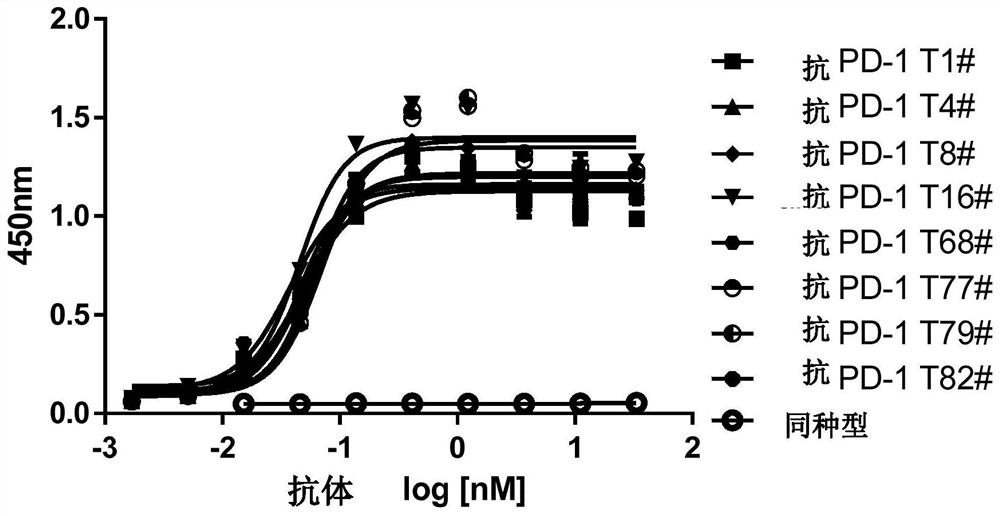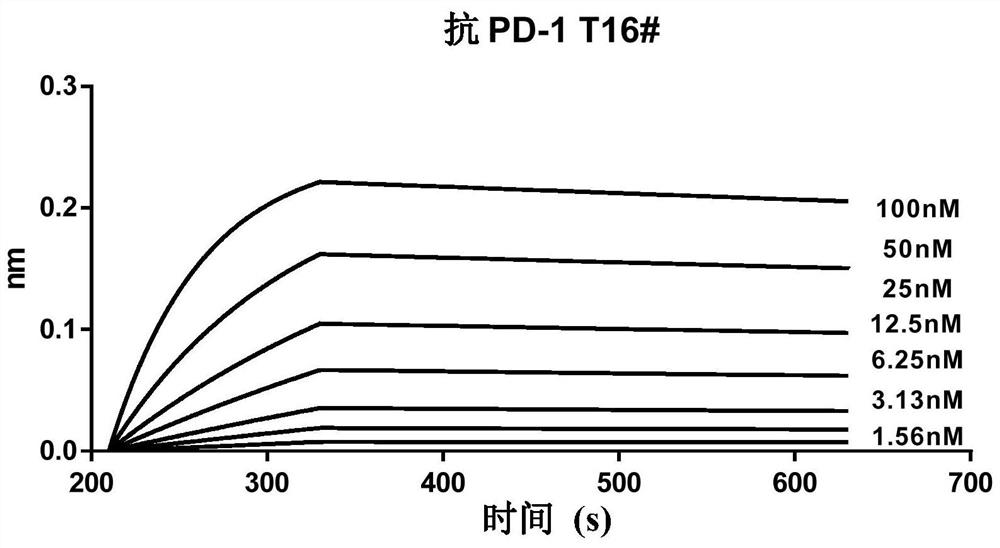Bispecific antibody targeting HER2 and PD-1 and application thereof
A bispecific antibody, PD-1 technology, applied in the direction of application, antibody, specific peptide, etc., can solve the problem of lower yield
- Summary
- Abstract
- Description
- Claims
- Application Information
AI Technical Summary
Problems solved by technology
Method used
Image
Examples
Embodiment 1
[0173] Example 1: Humanization of anti-PD-1 antibody
[0174] Anti-PD-1 human-mouse chimeric antibody, its variable regions (SEQ ID NO: 1 and 2) are obtained from hybridoma screening, and its constant region is derived from human antibody IgG. Chimeric antibodies need to be humanized, that is, the CDR sequence of the mouse is grafted to the human antibody variable region framework, in order to effectively reduce the immunogenicity of the antibody in clinical use. Synthesize CDR region primers according to the sequence, and combine with various variable region frameworks of human antibodies to form VH and VL. Apply PCR and DNA recombination technology to build onto the CH1 or Ck vector, and electrotransform into Escherichia coli to construct a humanized Fab phage library. After measuring the titer of the phage library, multiple rounds of adsorption-elution-amplification were performed with the antigen human PD-1 protein, and specific phage antibodies were enriched. Select the...
Embodiment 2
[0175] Example 2: Comparing Anti-PD-1 Antibodies
[0176] The variable region sequence of the humanized PD-1 antibody was connected to the human IgG constant region to construct a plasmid, and the protein was expressed by transiently transfecting cells, and the purity was detected by high performance liquid exclusion liquid chromatography (SE-HPLC). At the molecular level, the ability of 8 anti-PD-1 antibodies to bind to the antigen PD-1 and block PD-1 and PD-L1 was compared. The ELISA method was used to measure the blocking activity of the antibody. The operation was as follows: the antigen PD-1 protein was coated on the bottom of the 96-well plate, and a serially diluted anti-PD-1 antibody was added to it, and then biotinylated PD-L1 was added. When HRP- Streptavidin was combined with biotin to develop color with TMB, and finally the inhibition rate of the antibody was calculated (such as figure 1 ). The ELISA method is used to measure the binding activity of the antibody....
Embodiment 3
[0177] Example 3: Cloning and expression of bispecific antibodies
[0178] Two bispecific antibodies targeting HER2 and PD-1 were constructed in IgG-scFv configuration (such as Figure 5 ). One is to link the PD-1-targeting IgG antibody and HER2-targeting single-chain antibody with a linker (SEQ ID NO: 19) to form an anti-PD-1 / HER2 bispecific antibody. The other is to connect the HER2-targeting IgG antibody and the PD-1-targeting single-chain antibody with a linker (SEQ ID NO: 10) to form an anti-HER2 / PD-1 bispecific antibody. The single-chain antibody scFv uses the VH and VL of the parent antibody (such as anti-PD-1 antibody or anti-HER2 antibody) (G 4 S) 4 Chain connections are formed. Construction of plasmids and expression of purified antibodies. Such as Figure 6 As shown, the affinity of the scFv targeting PD-1 in the anti-HER2 / PD-1 bispecific antibody to the antigen was significantly reduced by flow cytometry; The scFv hardly binds to the antigen.
[0179] Selec...
PUM
 Login to View More
Login to View More Abstract
Description
Claims
Application Information
 Login to View More
Login to View More - R&D
- Intellectual Property
- Life Sciences
- Materials
- Tech Scout
- Unparalleled Data Quality
- Higher Quality Content
- 60% Fewer Hallucinations
Browse by: Latest US Patents, China's latest patents, Technical Efficacy Thesaurus, Application Domain, Technology Topic, Popular Technical Reports.
© 2025 PatSnap. All rights reserved.Legal|Privacy policy|Modern Slavery Act Transparency Statement|Sitemap|About US| Contact US: help@patsnap.com



